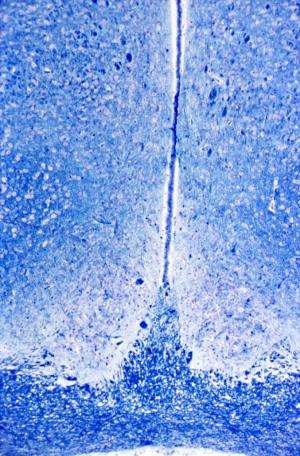October 4, 2013 report
Researchers find hormone vasopressin involved in jet lag

(Medical Xpress)—A team of researchers from several research centers in Japan has together found what appears to be a connection between the hormone vasopressin and jet-lag. In their paper published in the journal Science, the team describes experiments they conducted with test mice that indicate that repressing neural connections that respond to vasopressin reduced the time it took for them to readjust their circadian clock.
Adjustments to the circadian clock can be more than a nuisance for long distance flyers, research over the years has shown that it can cause stressed induced medical problems for those that work odd hours. For that reason, scientists have been looking for a way to reset the circadian clock much quicker than happens naturally. In this new effort the researchers looked at a part of the brain called the suprachiasmatic nucleus—it's believed to be the main region involved in monitoring the passage of time and hence the circadian clock. Upon closer scrutiny, they found that many of the neurons in that part of the brain had receptors that were sensitive to vasopressin.
To find out why, they genetically altered test mice to inhibit such receptors and then artificially altered their day/night schedule. They found that without the receptors the mice were able to adjust to a radically altered time schedule in just one day, as opposed to the week or more it took unaltered mice. Next, they tried giving test mice a chemical that is known to block the same receptors, but only in the brain (neurons with vasopressin sensitive receptors are found throughout the nervous system) and found the mice were able to readjust their internal clocks in three days, much faster than normal, but still not as fast as those without the receptors.
The findings by the team suggest that a cure for jet-lag may be on the way. The chemical given to the mice has not been tested yet to see if it has other side-effects, most particularly, whether it causes problems with the kidneys—vasopressin is known to play a role in causing the kidneys to retain water to help regulate salt levels throughout the body.
More information: Mice Genetically Deficient in Vasopressin V1a and V1b Receptors Are Resistant to Jet Lag, Science 4 October 2013: Vol. 342 no. 6154 pp. 85-90, DOI: 10.1126/science.1238599
ABSTRACT
Jet-lag symptoms arise from temporal misalignment between the internal circadian clock and external solar time. We found that circadian rhythms of behavior (locomotor activity), clock gene expression, and body temperature immediately reentrained to phase-shifted light-dark cycles in mice lacking vasopressin receptors V1a and V1b (V1a–/–V1b–/–). Nevertheless, the behavior of V1a–/–V1b–/– mice was still coupled to the internal clock, which oscillated normally under standard conditions. Experiments with suprachiasmatic nucleus (SCN) slices in culture suggested that interneuronal communication mediated by V1a and V1b confers on the SCN an intrinsic resistance to external perturbation. Pharmacological blockade of V1a and V1b in the SCN of wild-type mice resulted in accelerated recovery from jet lag, which highlights the potential of vasopressin signaling as a therapeutic target for management of circadian rhythm misalignment, such as jet lag and shift work.
© 2013 Medical Xpress



















